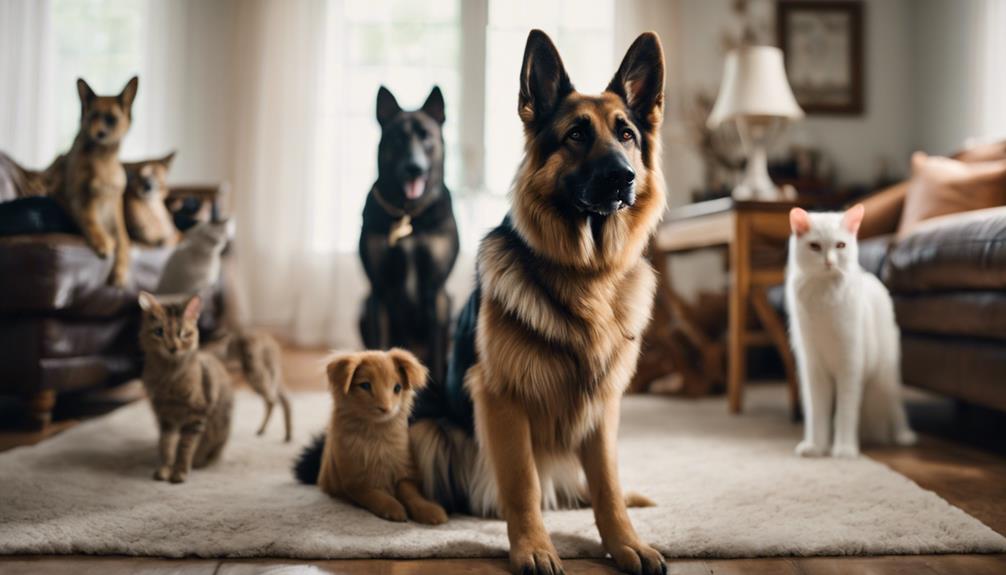🐾 Paw-some Partnership Alert! 🐾
As a pack of German Shepherd enthusiasts at MixGermanShepherd.com, we're always sniffing out the best products for our furry friends. Guess what? When you fetch something from Amazon through our links, we earn a little treat! 🦴
When introducing a German Shepherd mix into a multi-pet household, it's like navigating uncharted waters with seasoned companions. But, fear not, for there are strategies to help you chart a course towards a harmonious cohabitation. Understanding the dynamics between your pets is just the beginning; the real challenge lies in how you establish a balance that ensures everyone's well-being. So, how can you ensure a smooth integration that keeps tails wagging and purrs resonating?
Key Takeaways
- Establish distinct living spaces for each pet to prevent conflict and promote harmony.
- Use barriers and designated zones to create boundaries and reduce tension among pets.
- Monitor interactions closely, address behavioral challenges proactively, and seek professional guidance if needed.
- Promote positive reinforcement, consistency in training, and individualized attention to support the new addition's integration.
Preparing Your Home Environment
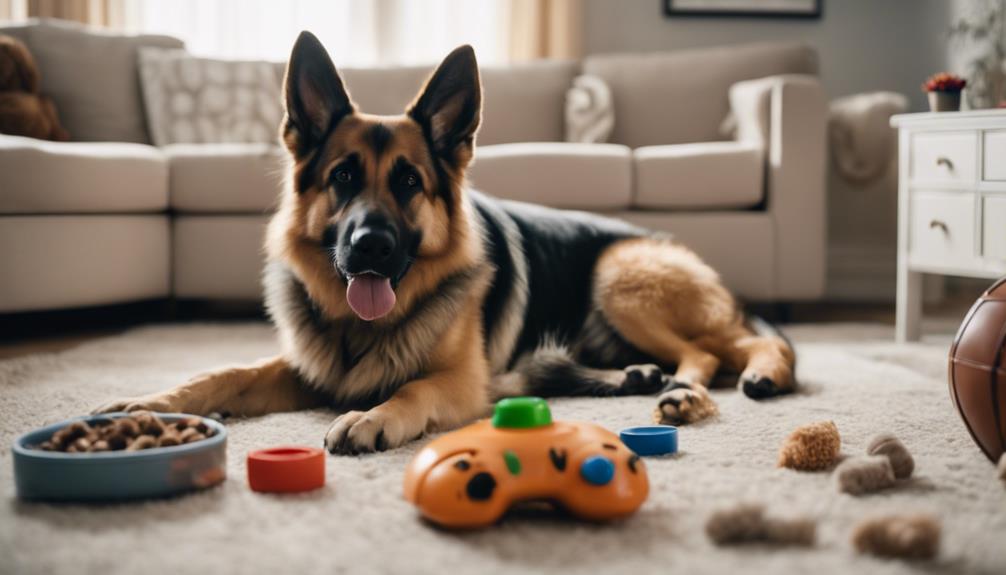
To ensure a smooth integration process, establish distinct living spaces for each pet in your household, minimizing potential conflicts while promoting a harmonious environment. When integrating a new German Shepherd mix into a multi-pet household, it is crucial to create separate areas where each pet can retreat to feel safe and comfortable. Providing ample toys, beds, and feeding stations for each pet helps prevent resource guarding and reduces the likelihood of territorial disputes. Consider the existing pets' personalities and preferences when setting up the environment, ensuring that each one has its own space tailored to its needs. By securing any potential hazards or escape routes, you can maintain a safe environment for all pets involved. Gradually introducing the scents and sounds of the new German Shepherd mix to the other pets can help familiarize them with each other's presence, paving the way for a smoother integration process. By preparing your home environment thoughtfully, you set the foundation for a successful and harmonious cohabitation among your pets.
Establishing Safe Spaces for Each Pet
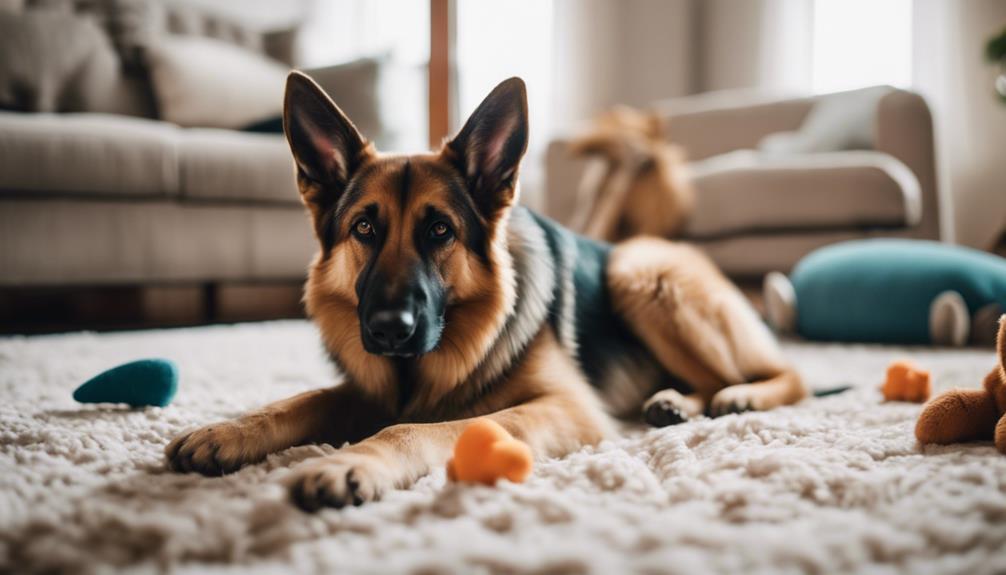
Designate individual zones for your pets and establish clear boundaries to provide them with their own safe havens. Ensure they have access to hiding spots, crates, or elevated areas where they can seek privacy or relaxation. By considering each pet's preferences and creating a tailored environment, you can promote a comfortable and stress-free living space for all your furry companions.
Individual Pet Zones
Establishing safe spaces for each pet in a multi-pet household through individual pet zones is crucial for promoting harmony and reducing conflicts. Here are key points to consider:
- Designated Areas: Assign specific locations where each pet can eat, rest, and have their own belongings.
- Territorial Reduction: Personalized zones help minimize territorial disputes and foster a sense of ownership for each pet.
- Comfort and Stress Reduction: Safe spaces enhance comfort, reduce stress, and contribute to a peaceful environment for all pets.
- Resource Guarding Prevention: Implementing individual pet zones is an effective strategy to prevent resource guarding behaviors and ensure a harmonious coexistence among pets.
Clear Boundaries Set
Creating clear boundaries for each pet in your multi-pet household is essential for establishing safe spaces and promoting harmony among your furry companions. When introducing a new dog, it's crucial to set aside specific areas or rooms for each pet to retreat to, ensuring they have their own safe space. Utilize baby gates or barriers to create boundaries between pets, allowing them to have separate areas where they can feel secure. Providing individual feeding stations and water bowls will help prevent competition and resource guarding. Additionally, offering separate sleeping areas or crates for each pet can give them a comfortable and secure space to relax. Implementing a rotating schedule for outdoor and indoor activities will ensure each pet receives equal time and attention, further solidifying the clear boundaries set within your multi-pet household.
Supervised Initial Interactions
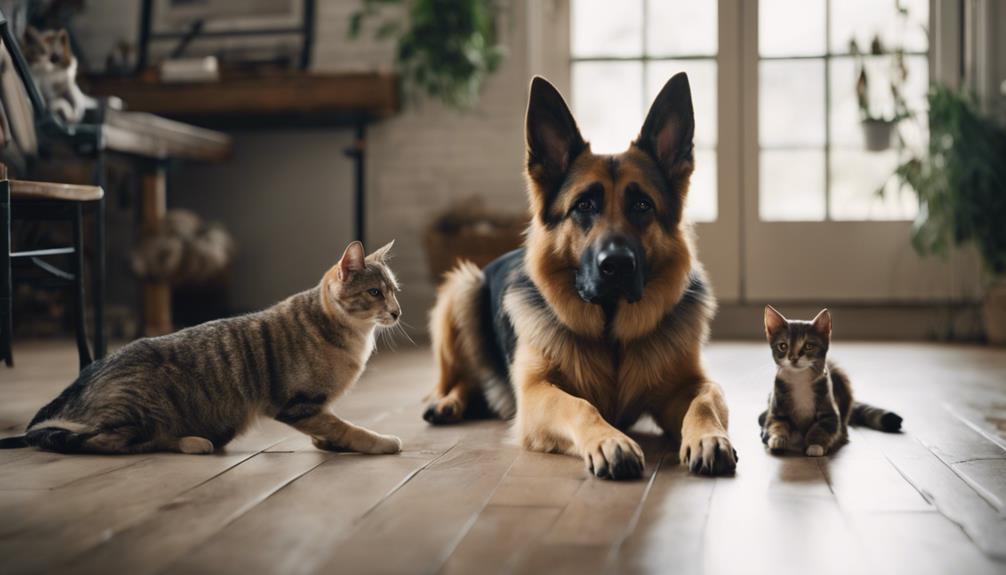
Supervise the initial interactions between your German Shepherd mix and other pets to assess behavior and reactions effectively. Here are some key points to consider during this crucial phase:
- Monitor Closely: Keep a close eye on the body language and vocalizations of all pets involved. This observation can provide valuable insights into their comfort levels and boundaries.
- Use Positive Reinforcement: Utilize positive reinforcement techniques and treats during supervised meetings. Rewarding good behavior can help create positive associations and reduce tension among the pets.
- Gradual Acclimation: Gradually increase the duration of interactions while maintaining supervision. This gradual approach allows all pets to acclimate to each other's presence and behavior over time.
- Prevent Conflicts: Supervising initial interactions is essential for preventing conflicts, establishing hierarchy, and promoting a smooth integration process in a multi-pet household. By closely monitoring and guiding these interactions, you can foster a harmonious environment for all your pets.
Understanding Canine Body Language
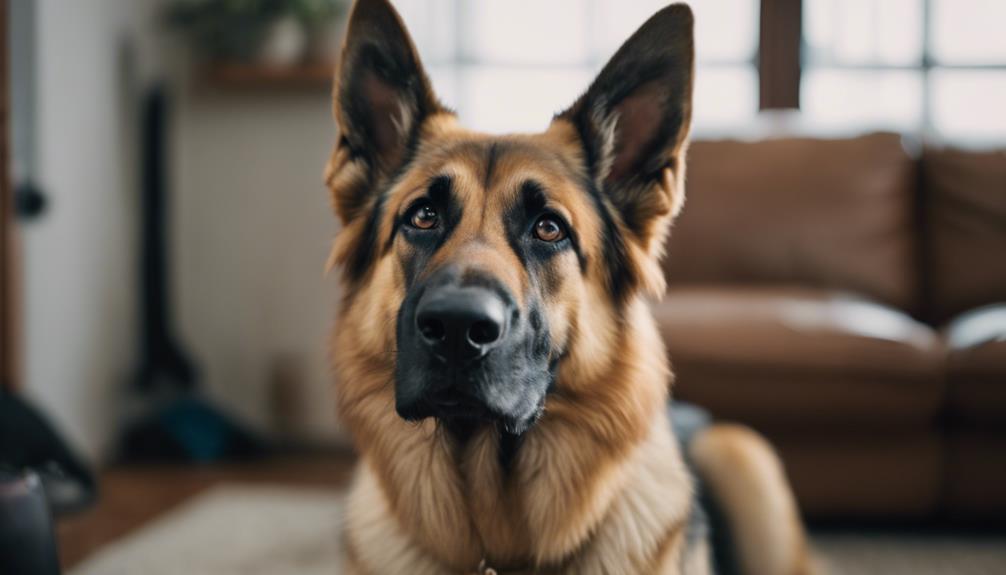
Understanding canine body language is crucial in deciphering your German Shepherd mix's emotions and intentions. You should pay attention to cues like tail wagging, ear movement, and eye contact, as these can provide valuable insights into your dog's state of mind. Interpreting these signals correctly will help you create a harmonious environment for all pets in your household.
Dog Communication Cues
To decipher a dog's emotions accurately, pay close attention to their body language, including tail wagging, ear position, and facial expressions. Understanding canine communication cues is crucial for building a strong bond with your furry friend. Here are some key points to consider:
- Tail Wagging: The speed and height of the wag can indicate different emotions.
- Ear Position: Erect ears signal alertness, while flattened ears may signify fear or submission.
- Facial Expressions: Raised eyebrows can show surprise, while a wrinkled forehead might indicate aggression.
- Vocalizations: Different barks, growls, or whines convey varying messages.
Recognizing Stress Signals
To effectively bond with your German Shepherd mix and other pets, it's crucial to recognize the stress signals displayed through canine body language. Signs such as a tucked tail between the legs can indicate fear or discomfort in dogs. Additionally, behaviors like lip licking, yawning, or raised hackles along the back may signal stress or anxiety in your furry companion. Pay attention if your dog avoids eye contact, turns away, or displays excessive panting and drooling, as these can be signs of stress or nervousness. Understanding these cues can help you create a harmonious environment for all your pets, ensuring they feel safe and secure in their interactions with each other.
Interpreting Wagging Tails
When observing a dog's tail wagging, it's essential to consider various factors beyond just the motion itself to accurately interpret their emotions and intentions.
Key Points to Consider:
- A wagging tail doesn't always indicate a happy dog; context and other body language cues are crucial to understand the dog's emotions.
- Different wagging patterns can signal various emotions such as excitement, fear, aggression, or insecurity.
- The speed, height, and direction of the wag can provide insights into the dog's state of mind and intentions.
- Stiff wagging or a low tail position might indicate stress, discomfort, or a potential threat.
Implementing Positive Reinforcement Techniques
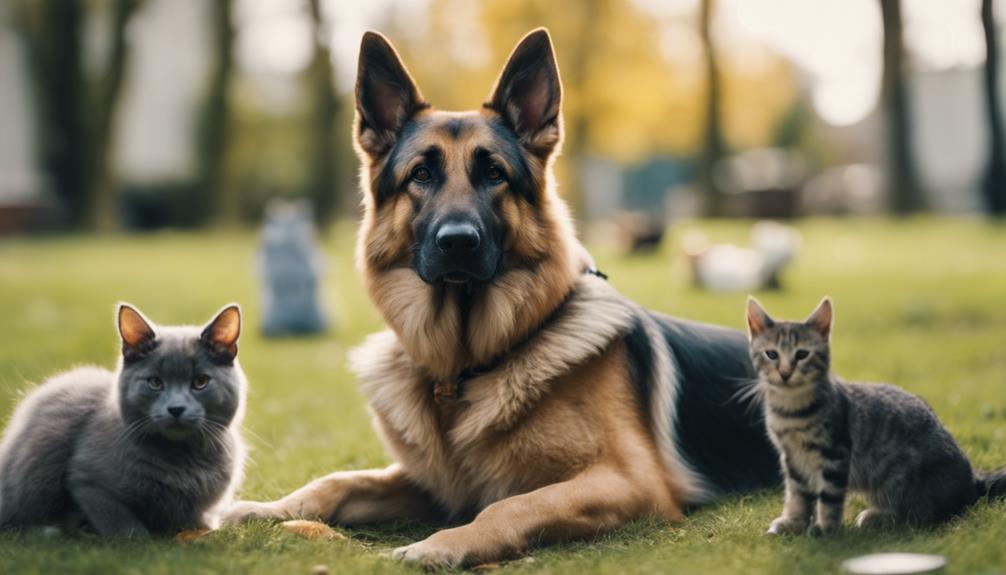
Implementing positive reinforcement techniques with your German Shepherd mix involves consistently rewarding desired behaviors to foster a harmonious integration into your multi-pet household. By using treats, praise, and toys as rewards, you can reinforce good behavior and create a positive training environment. It is crucial to be consistent in rewarding positive behaviors to effectively train your dog and ensure a smooth transition into a multi-pet household. Avoid punitive methods and instead focus on encouraging behaviors that promote cooperation with other pets.
| Positive Reinforcement Techniques | Benefits |
|---|---|
| Rewards for desired behaviors | Encourages repetition |
| Consistency in training | Builds positive association |
| Avoiding punishment-based methods | Promotes harmony |
| Patience and clear communication | Key elements for success |
Managing Feeding and Resource Sharing
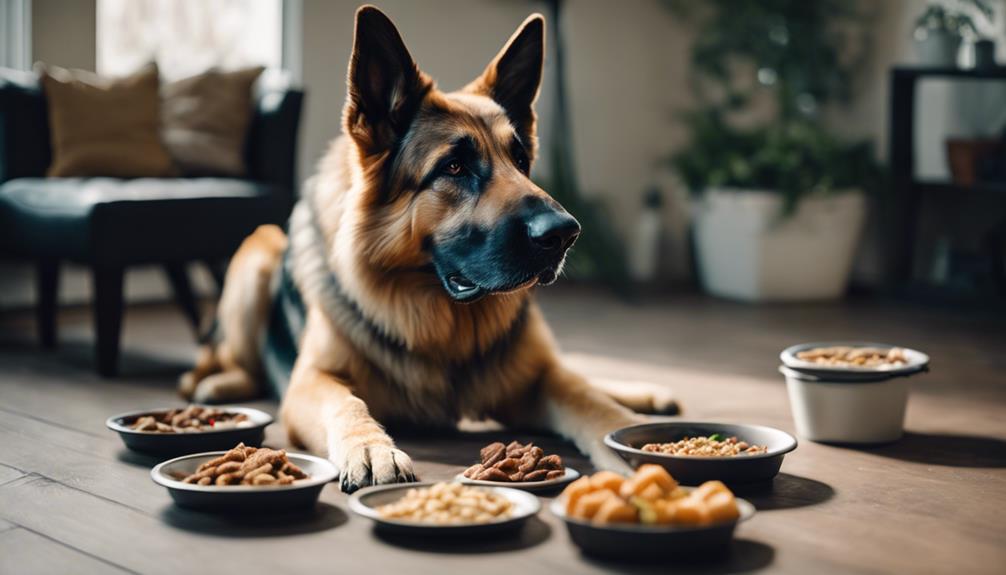
Consider creating designated feeding areas for each pet in your multi-pet household to manage feeding and resource sharing effectively. This simple adjustment can help prevent food-related conflicts and promote harmony during meal times. To further assist you in this process, here are some essential tips:
- Supervise meal times: Ensure fair access to resources by monitoring each pet during feeding. This oversight can prevent resource guarding and encourage a peaceful dining experience for all.
- Utilize separate feeding areas: Establish distinct spaces for each pet to enjoy their meals without feeling threatened or rushed. This strategy can reduce tension and promote a sense of security during feeding times.
- Implement interactive feeders: Engage pets mentally by incorporating interactive feeders or puzzle toys into their meal routines. This not only helps prevent food aggression but also provides mental stimulation and enrichment.
- Adjust portions accordingly: Monitor food intake and adjust portions as needed to meet each pet's dietary requirements. This practice promotes overall health and ensures that each pet receives the appropriate nutrition for their individual needs.
Addressing Behavioral Challenges Proactively

To proactively address behavioral challenges in a multi-pet household, it is essential to establish clear boundaries and reinforce positive behaviors consistently. When dealing with resource guarding behavior, consider providing separate feeding areas for each pet and supervising their interactions during meal times. Utilizing positive reinforcement techniques can effectively address behavioral issues promptly. Obedience training is a valuable tool to instill discipline and promote good behavior among all pets. Implementing structured routines and enforcing consistent rules can help create harmony and reduce conflicts in the household. Seeking guidance from professional trainers or behaviorists is advisable to proactively manage and address any behavioral challenges that may arise. It's crucial to closely monitor interactions between pets and intervene when necessary to prevent conflicts and encourage positive behaviors. By being proactive and using positive reinforcement methods, you can create a peaceful and cohesive environment for all your pets to thrive in.
Providing Individual Attention and Playtime
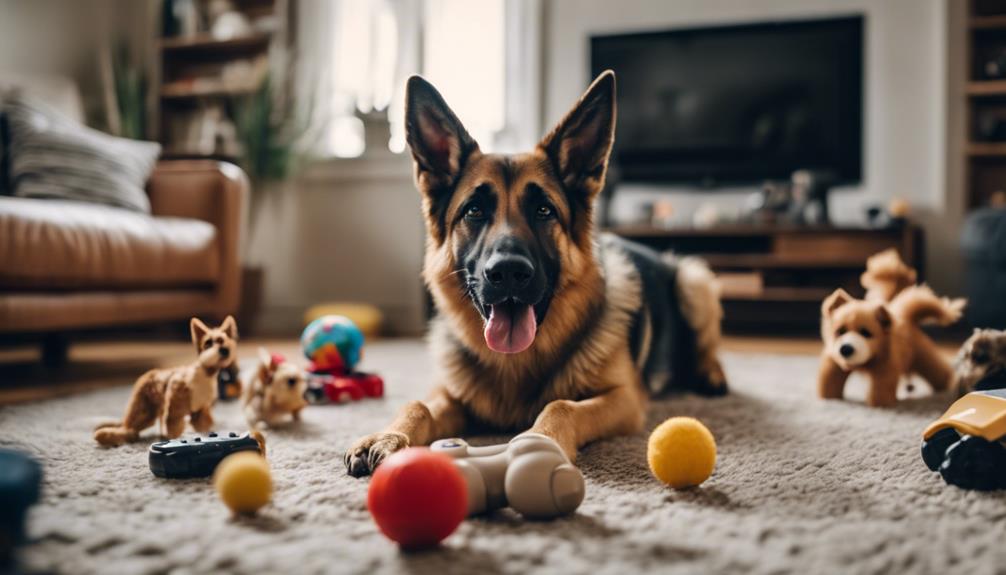
To ensure a harmonious integration of your German Shepherd mix into a multi-pet household, prioritizing individual attention and playtime is key for fostering healthy relationships and preventing behavioral issues. Here are some essential strategies to consider:
- Dedicated One-on-One Playtime: Allocate specific time slots to engage solely with your German Shepherd mix, offering undivided attention and affection to strengthen your bond.
- Engage in Interactive Games: Incorporate activities like fetch or tug-of-war to keep your dog mentally and physically stimulated during play sessions, promoting a healthy outlet for their energy.
- Rotate Play Activities: Keep your German Shepherd mix engaged by varying the types of games and exercises, preventing boredom and encouraging their interest in playtime.
- Incorporate Training Exercises: Use playtime as an opportunity to reinforce obedience commands and training, enhancing mental stimulation and reinforcing positive behaviors in a fun and interactive manner.
Monitoring and Evaluating Interactions Regularly
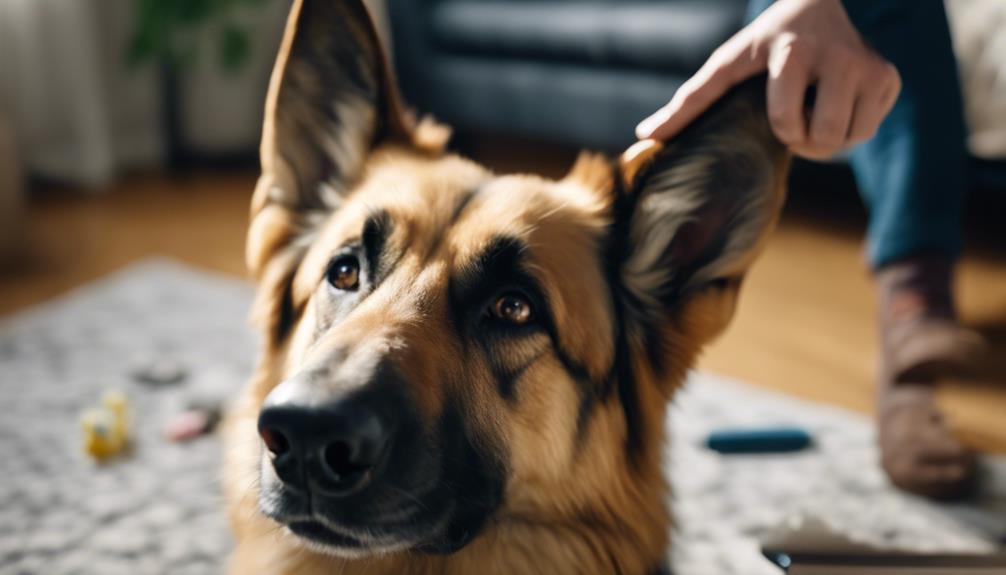
When integrating your German Shepherd mix into a multi-pet household, it is crucial to regularly monitor and evaluate interactions. Observe for any signs of aggression or tension, paying close attention to body language, vocalizations, and overall behavior. By documenting social dynamics and addressing potential conflicts promptly, you can ensure a smoother integration process for all pets involved.
Behavior Observation Techniques
Regularly monitoring and evaluating interactions between your German Shepherd mix and other pets is crucial for assessing integration progress in a multi-pet household. When observing behaviors, pay close attention to the following:
- Body Language: Watch for signs of tension, relaxation, fear, or dominance in both the German Shepherd mix and other pets.
- Vocalizations: Take note of barks, growls, whimpers, or other sounds that indicate communication or distress.
- Interactions: Observe how the pets engage with each other during play, feeding, or resting times.
- Response to Cues: Evaluate how well your German Shepherd mix follows commands, responds to redirection, and respects social signals from other pets.
Documenting Social Dynamics
Observe and document social interactions between your German Shepherd mix and other pets regularly to track dynamics within your multi-pet household. By monitoring and evaluating these interactions, you can gain valuable insights into the relationships forming among your pets. Document any changes in behavior or body language to assess the overall dynamics effectively. Here is a table to help you track and analyze the interactions:
| Types of Interactions | Frequency | Observations |
|---|---|---|
| Play Sessions | Daily | Positive |
| Feeding Times | Twice a day | Neutral |
| Resting Areas | Nightly | Competitive |
| Grooming Sessions | Weekly | Affectionate |
| Training Sessions | Bi-weekly | Respectful |
Regularly updating this table will assist you in spotting patterns and addressing any potential conflicts promptly.
Addressing Potential Conflicts
To effectively address potential conflicts in your multi-pet household, it is imperative to actively monitor and evaluate interactions between your German Shepherd mix and other pets on a regular basis. Here are some key steps to consider:
- Regular Monitoring: Keep a close eye on how your German Shepherd mix interacts with other pets in the household.
- Behavior Evaluation: Pay attention to body language, vocalizations, and overall behavior during these interactions to spot any signs of conflict.
- Prompt Intervention: Step in quickly to prevent any conflicts from escalating and to maintain a peaceful environment.
- Identify Triggers: Watch out for behaviors like resource guarding, territorial issues, or aggression towards other pets and address them promptly.
Seeking Professional Training or Guidance
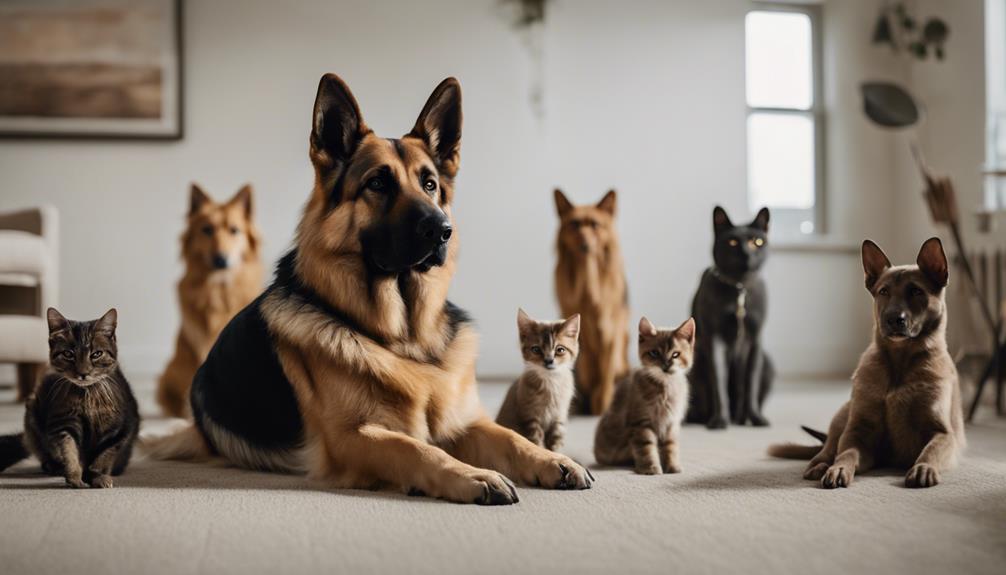
Seeking professional training or guidance is essential for effectively integrating a German Shepherd mix into a multi-pet household. Professional trainers possess the expertise to offer valuable insights into managing interactions, establishing boundaries, and fostering harmony among pets. They can provide guidance on introducing the new dog to existing pets, ensuring a smooth transition and minimizing conflicts. Additionally, professional help is crucial for addressing any behavioral issues that may arise during the integration process. By seeking professional guidance, pet owners can benefit from personalized strategies tailored to their specific situation, making the integration process more manageable and successful. Trainers can also assist in creating a structured plan for the introduction, helping all pets adjust to the new dynamic within the household. With the assistance of training experts, pet owners can navigate the complexities of integrating a German Shepherd mix into a multi-pet environment with confidence and expertise.
Creating Consistent Daily Routines

How can consistent daily routines benefit the integration of a German Shepherd mix into a multi-pet household? Establishing structured schedules and sticking to them is essential for creating a harmonious environment for all pets. Here's why:
- Security and Stability: Consistent daily routines help German Shepherd mixes feel secure and reduce anxiety in a multi-pet household.
- Predictability and Structure: Setting fixed feeding, walking, and play times creates predictability and structure for all pets, aiding in their overall well-being.
- Smooth Integration: Regular routines assist in integrating the new German Shepherd mix smoothly into the existing pet dynamics, minimizing conflicts.
- Positive Behaviors: Providing consistency in activities and interactions fosters a sense of stability and harmony among all pets, promoting positive behaviors in the long run.
Fostering Positive Relationships Among Pets
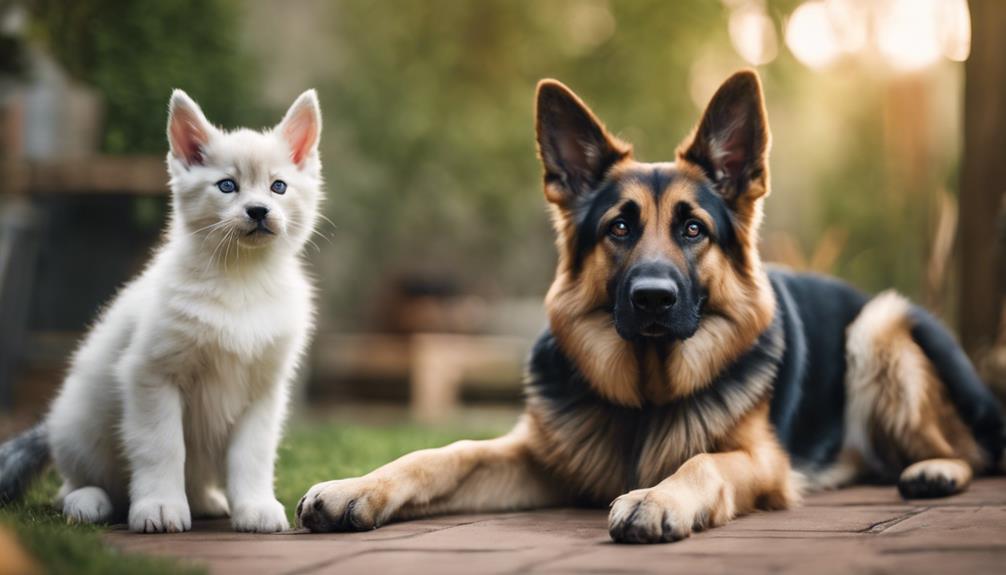
Establishing positive relationships among pets in a multi-pet household requires careful supervision and strategic interventions. When introducing a German Shepherd Mix into a home with other pets, it is crucial to allow controlled interactions to develop positive associations. Positive reinforcement can be a powerful tool in encouraging calm and friendly behavior between pets, rewarding moments of harmony. Providing separate spaces where each pet can retreat to when needed helps prevent conflicts and gives them a sense of security. It's essential to monitor the pets' body language during interactions and intervene if tensions start to rise, ensuring a safe environment for all animals involved.
To foster positive relationships, gradually increase supervised interactions between the pets. This gradual approach can help promote bonding and acceptance among them over time. By facilitating these interactions and rewarding desirable behaviors, you can encourage a harmonious coexistence in your multi-pet household, including your German Shepherd Mix. Remember that patience and consistency are key in building lasting positive relationships among your furry companions.
Celebrating Milestones and Progress
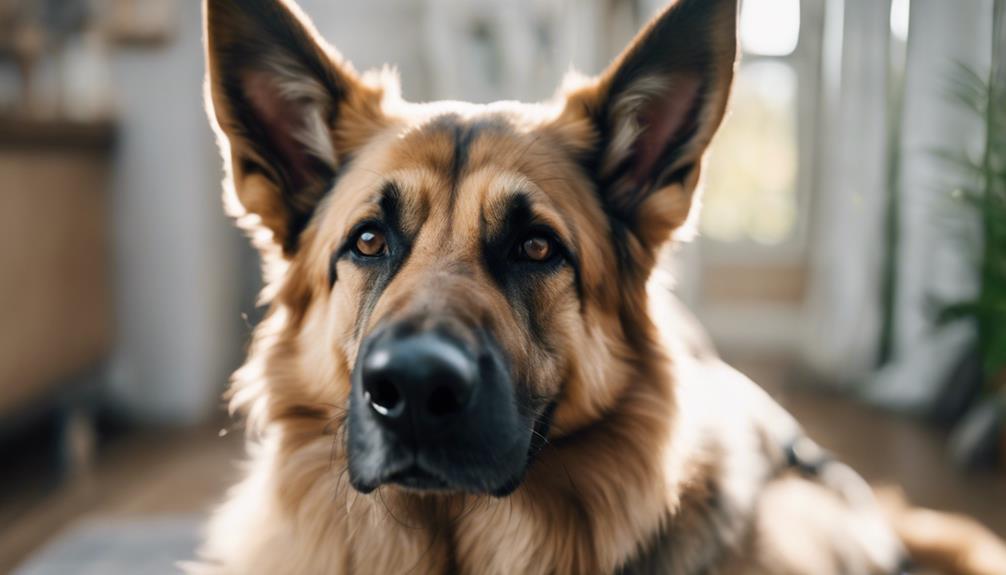
To celebrate the progress made in fostering positive relationships among your pets, acknowledging and commemorating milestones is essential in integrating your German Shepherd Mix successfully into your multi-pet household. Celebrating milestones not only recognizes achievements but also reinforces positive behaviors and interactions among your pets. Here are four key ways to celebrate milestones and progress in your integration journey:
- Recognize and celebrate positive interactions: Highlight and praise moments of harmony, playfulness, and cooperation between your German Shepherd mix and other pets.
- Acknowledge milestones: Celebrate successful introductions, improved socialization skills, and reduced conflicts as significant steps towards a harmonious multi-pet environment.
- Document progress: Keep track of the integration journey by documenting milestones with notes, photos, or videos to visualize the positive changes over time.
- Reward good behavior: Reinforce positive interactions with treats, praise, and attention to encourage continued progress and strengthen the bond between your pets.
Frequently Asked Questions
What Dogs Go Well With German Shepherds?
When choosing companionship for your German Shepherd, consider breed compatibility. Look for dogs with matching energy levels, like Golden Retrievers, to make great companions. Implement proper socialization strategies for successful integration into a multi-pet household.
Can German Shepherds Live With Other Pets?
When living with other pets, German Shepherds can thrive. Training techniques, socialization processes, and behavioral adjustments are key. Start early, provide supervision, and establish boundaries for a harmonious multi-pet household.
Do German Shepherds Like to Have Another Dog?
Having another dog can benefit your German Shepherd mix through socialization benefits, understanding behavioral cues, and reinforcing pack dynamics. Proper introductions and supervision are crucial to fostering a harmonious relationship with other pets.
How Do You Introduce a German Shepherd to Another Dog?
To introduce a German Shepherd to another dog, start by meeting on neutral ground. Use positive reinforcement, treats, and praise to encourage calm behavior. Supervise playtime closely and take it slow to establish boundaries and ensure a smooth integration process.
Conclusion
As you navigate the integration of a German Shepherd mix into your multi-pet household, remember to balance patience with persistence. Celebrate small victories while addressing challenges head-on. By creating a harmonious environment through careful planning and consistent training, you can foster positive relationships among all your furry companions. Embrace the journey of building a cohesive pack, one step at a time.
